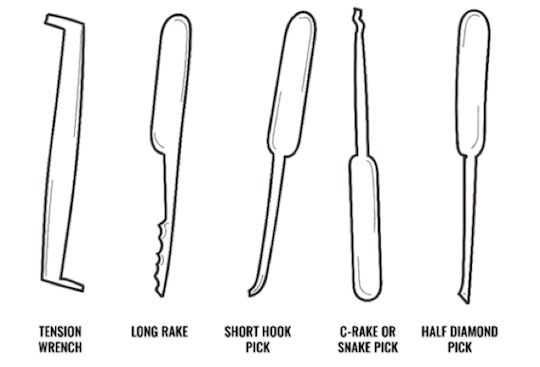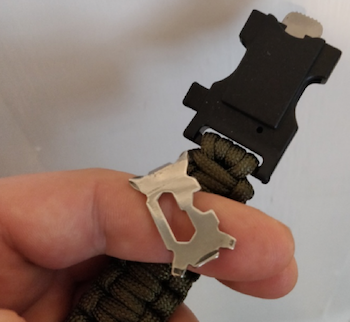Dear Black Bag Confidential Reader,
Sometimes it’s not easy to explain certain spy and survival techniques in writing. Which is why I included a video in my answer to the first of this week’s mailbag questions. In it, you’ll discover how to pick a lock using just two simple tools.
Then you’ll find out how to tell if your computer has been hacked, why the door to your safe room should open outward (and a great solution if your house isn’t built that way) and where to keep your valuables when you stay at a hotel.
Take a look.
I recently bought one of your lock picking sets and am having a problem with the tension wrench. The “ears” on it are too long to let me insert it into the plug. It will only go in about the space of one pin. Should I grind a bit off? It looks like they need about 1/8″ off.
— Larry G.
I think I understand your confusion, Larry. First, DO NOT grind off any part of the tension wrench. You will render it useless. It is designed to work as intended.
Now, let’s take a look at the different tools in your lock pick set:

To open a standard lock, you’ll need two of these tools: the tension wrench and one of the other four picks — I recommend starting with the L-rake. The 90-degree angle “ears” (as you called them) on the tension wrench are the part you insert into the lock.
With the tension wrench, apply slight pressure to the lock. Insert the L-rake into the keyhole with the jagged edge facing the direction of the pins. Move the L-rake back and forth — like you’re brushing your teeth.
Once all the pins are in place, you will feel the wrench “give” a little under the weight of your finger as it turns the lock, opening the door.
Click here to watch a video of me showing someone from my production team exactly how to do this. If you’re a visual learner, it will make a lot more sense to see this technique in action.
How can you tell if you’ve been hacked? How would you know if someone (cyberterrorists, the government, an ex-lover) has been reading your emails?
— Sarah F.
There are a number of ways to tell if your computer has been hacked or if someone is spying on you. One of the most obvious signs is if you are constantly getting fake anti-virus pop-ups on your computer. This is one of the most common schemes hackers use to steal information from you — by getting you to click on the fake anti-virus notification.
Another indication that your computer has been compromised is constant internet website redirects sending you to websites you didn’t intend to visit. If your computer starts doing strange things like these, there is a good chance someone has hacked it.
Remember to always use a reputable anti-virus program as well as a VPN (virtual private network) like TunnelBear to safeguard your privacy.
Regarding safe room construction… why should the door swing outward and not inward?
— Andrew N.
The problem with inward-swinging doors is that they aren’t as strong as outward-swinging doors. When criminals kick in a door, the majority of the time it will be an inward-swinging door — most homes are built with these types of doors.
An inward-swinging door is only as strong as the bolts or nails holding the hinge in place. Most outward-swinging doors have full contact between the door and the frame, making them more difficult to break down.
Since most homes have inward-swinging doors, I recommend installing a product called Nightlock. This is basically a metal brace you screw into the floor behind your door to prevent it from being kicked in. Nightlock is so effective because it uses the strength of the floor to withstand tremendous force.
I just received my 14-in-1 survival bracelet. Where can I find a list of its features and how to use them?
— Lou G.
The 14-in-1 survival bracelet is a great choice for everyday carry. It packs a ton of tiny tools into one easy-to-wear bracelet.
It’s got a detachable 8-in-1 tool (see photo below) and scraper, a compass, thermometer, whistle and flint fire starter. Plus, the bracelet itself is made from over 11 feet of paracord, which has a variety of uses from simply tying objects together to escaping certain restraints.

What about room safes? Can room safes in hotel rooms be trusted? Or should you carry your passport/backup cash at all times (maybe use a money belt)?
— Ron V.
You should absolutely keep all important documents on you at all times when traveling. The fact is hotel room safes cannot be trusted, because so many people use them.
Consider the number of guests who have probably used the safe in their room and locked themselves out of it. The hotel would need to have a way to access each safe in the event this happens. Therefore, any hotel employees could potentially access the safe in your room, which is why I recommend never using it to store valuables.
Instead, try an ankle wallet like the Eagle Creek Undercover Leg Wallet or something like the Shacke Hidden Travel Belt Wallet, which hangs down inside your pants. I’ve used this gadget when traveling — it’s a great way covertly keep important items on you.
Stay safe,

Jason Hanson






